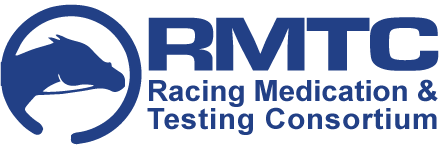Tactical Research
Background:
The funding of scientifically-valid research projects is a cornerstone of RMTC’s mission. Targeted research directed toward developing analytical methods for the detection of prohibited substances or toward developing scientifically-defensible withdrawal times and/or thresholds for therapeutic substances is given highest priority, along with broader methodological research.
The RMTC moved away from the RFP process in 2005 and focused on administration studies for medications of therapeutic value to the horse. Twenty-horse administrations were performed at the University of Florida Racing Laboratory on fit, treadmill-trained Thoroughbred and Standardbred horses in order to develop reliable, statistically-valid withdrawal times and relevant regulatory concentrations. Over $700,000 was spent on the project, which was the largest of its kind ever conducted in horse racing in any country.
Overall, RMTC has funded over $2 million in drug testing research.
The RMTC’s main research focus has now shifted from therapeutic medications to drugs that pose an immediate threat to the integrity of racing. RMTC subsidizes the analysis of unknown substances (vials, bottles, syringes, etc.) for racing commissions on an ad hoc basis to determine whether the substances contain doping agents that could produce a pharmacologic effect on raceday. In addition, the RMTC supports detection studies on “unknown” and prohibited substances.
RMTC’s Tactical Research Program works diligently to identify new substances of interest, coordinate with investigators to ensure inappropriate substances are removed from the race track setting, and to help provide information in prosecutions. The goal of this program is to ensure integrity in the sport as well as protect the safety and welfare of the equine and human participants by quickly responding to potential threats.
RMTC Tactical Research Program Accomplishments
- Identification of unknown substances as dichloracetic acid and tadalafilin in a case for the Delaware Racing Commission through a coordinated effort between the RMTC Tactical Research Program and LGC Sports Science-Lexington
- Coordination with the Organization of Racing Investigators and AQHA in confiscation and identification of illegal new veterinary medications
- Sharing of several laboratory tests for illicit substances prior to availability of those tests to the general public
- Funding of two post-doctoral research fellowships – supporting the professional development of individuals who are working in racing laboratories on issues such as therapeutic medications, protein-based drugs and biomarkers for shockwave therapy
- Coordination of the work of multiple U.S.-based laboratories on the determination of a threshold level for cobalt including performing an administration study as well as determining normal levels of cobalt in racing horses – resulting in threshold and penalty recommendations
- Recommended an appropriate threshold for gamma aminobutyric acid (GABA) – an illicit substance often administered on race day – based on an administration study and the determination of normal levels of GABA in racing horses
- Purchased and performed analysis of substances of concern used by trainers and veterinarians in race horses
- Tested illegally-compounded substances confiscated in various jurisdictions to develop analytical testing for post-race detection for substances of concern
- Coordinated and partly funded an equine hair testing workshop leading to the implementation of this form of testing at several laboratories across the U.S.
- Provided assistance in an out-of-competition “super testing” effort involving over 100 horses racing in New Mexico
- Assisted with barn and vehicle/veterinary truck inspections in New Mexico and Minnesota
- Supported the development of an out-of-competition testing program in West Virginia and assisted with commission test barn protocols
- Proposed an expanded out-of-competition testing Model Rule and developed a Prohibited Substances List currently being considered for adoption by the RCI


